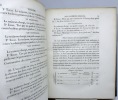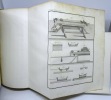COULOMB (Charles-Augustin)
Théorie des machines simples, en ayant égard au frottement de leurs parties et a la roideur des cordages
Paris, Bachelier, 1821. In-4, VIII-368 pp et X planches, demi-basane verte, dos lisse orné, tranches mouchetées (frottements, mors du plat supérieur partiellement fendu, quelques rousseurs).
Reference : 15114
Nouvelle édition. Bien complet des 10 planches. * Voir photographie(s) / See the picture(s). * Membre du SLAM et de la LILA / ILAB Member. La librairie est ouverte du lundi au vendredi de 14h à 19h. Merci de nous prévenir avant de passer,certains de nos livres étant entreposés dans une réserve.
Bookseller's contact details
L'Ancienne Librairie
M. Alban Caussé
3 Rue Pierre l'Ermite
75018 Paris
France
librairie.ancienne.paris@gmail.com
09 78 81 38 22
Payment mode



Sale conditions
conforme aux règles du SLAM
1 book(s) with the same title
"COULOMB, (CHARLES AUGUSTIN) - THE PRIZE-WINNING MÉMOIR CREATING THE SCIENCE OF FRICTION.
Reference : 44907
(1785)
Théorie des Machines Simples, en ayant égard au Frottement de leurs Parties, et a la Roideur des Cordages. piece qui a remporté le Prix double de l'Academie des Sciences pour l'année 1781.
Paris, Moutard, Panckoucke, 1785. 4to. Extract from ""Mémoires fe Mathematique et de Physique, Présentés à l'Academie des Sciences par divers Savans"", Tome X. Withtitlepage to vol. X. Pp. 131-332 and 5 folded engraved plates. The memoir has also its own titlepage. Fine and clean. Wide-margined.
First edition of this monumentalwork by which Coulomb CREATED THE SCIENCE OF FRICTION.""1781 saw him win the Academy prize for his mémoir ""Théorie des Machines Simples,"" in which the results of his experiments on the friction of different bodies slipping on one another (dry, or coated with greasy substances) were presented.""(Timoshenko p. 48).""Coulomb’s most celebrated study, one that brought him immediate acclaim, was ""Théorie des machines simples,"" his prize-winning friction study of 1781. He investigated both static and dynamic friction of sliding surfaces and friction in bending of cords and in rolling. From examination of many physical parameters, he developed a series of two-term equations, the first term a constant and the second term varying with time, normal force, velocity, or other parameters. In agreement with Amontons’s work of 1699, Coulomb showed that in general there is an approximately linear relationship between friction and normal force"" but he extended the investigation considerably to show complex effects due to difference in load, materials, time of repose, lubrication, velocity, and other considerations. Coulomb’s work in friction remained a standard of theory and experiment for a century and a half, until the advent of molecular studies of friction in the twentieth century. To quote Kragelsky and Schedrov’s recent monograph (p. 52) on the history of friction: ""Coulomb’s contributions to the science of friction were exceptionally great. Without exaggeration, one can say that he created this science.""(DSB).Poggendorff I:487.,
 Write to the booksellers
Write to the booksellers






